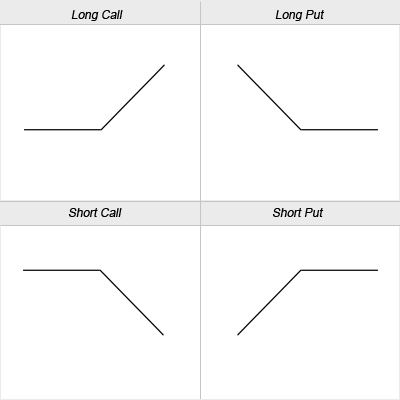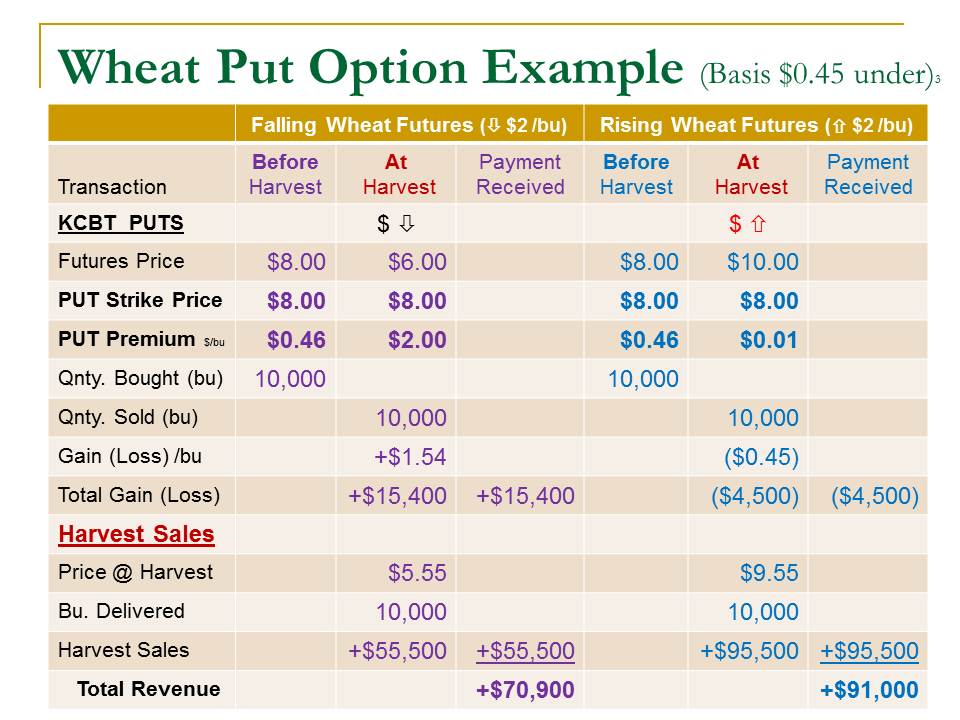Put call options grain
With the Chicago Board of Trade options contracts that began trading in late and earlyfarmers can now buy price insurance for their corn, wheat and soybean crops as well as for soybean meal. This new tool has both positive and negative dimensions. The positive aspects include 1 the ability to protect against declining crop prices while retaining the opportunity to gain if prices rise, 2 increased marketing flexibility in case you price your crop before harvest but yields are severely reduced by adverse weather.
On the negative side of the ledger, options markets make your marketing job more complex because of new terminology and the wider range of pricing alternatives that now are available.
GRAIN OPTIONS BOOST MARKETING FLEXIBILITY
Also, in deciding how and when to market your crops as effectively as possible, you need to watch what's happening in the options markets along with cash, futures and forward contracting prices.
There are several ways options markets can be used in marketing grain and livestockas well as in feed purchases. The simplest and most direct use is for buying price insurance, in effect insuring that your selling price will not be below some specific level.
You can do this in much the same way as you would buy insurance for your vehicles or farm buildings. Grain options contracts are available for the same delivery months as futures contracts. The options markets provide several different price insurance levels to choose from, each having a different insurance premium. These insurance levels are called strike prices.
The strike prices are fixed during a given marketing year, except that lower or higher strike prices may be added in times of rising or falling market prices.
Once a new strike price has been added, it continues to be available until the option contract for that delivery month expires. In contrast to the strike price, the insurance premium can change daily and is determined by the interaction of buying and selling orders in the trading pit at Chicago.
The premium is the cost of buying price insurance and must be paid when the option contract is purchased.
In addition to the premium, option purchase costs include a commodity brokerage fee that typically is about one-half to one cent per bushel on 5, bushel options contracts. The easiest way to obtain price insurance for your crop with the options market is by buying put options from a commodity broker.
It is important to note that there are two separate options markets for each commodity: For trading to take place in either market, a buyer of the option and a writer or seller of the option are required.
Buying a put, gives you the right but not the obligation to sell your product on the underlying futures contract at a specific price.
Collecting Option Premium In The Grain Market
Buying a call option gives you the right but not the obligation to buy a product on the underlying futures contract at a specific price.
The underlying futures contract is the one with the same delivery month as the option. The call market is used commonly for price protection by processors, exporters and livestock feeding operations that want to insure a maximum purchasing price for grain or soybean meal.

In buying puts to insure a minimum selling price, the initial outlay for the premium and the brokerage fee are your total financial exposure in options markets. Unlike futures trading, if you buy options you will not be asked to deposit additional money with the broker, no matter how high or how low prices go. If prices are low at harvest time and you had purchased put options earlier at a strike price above the current futures price, you would be in a position to collect on your insurance policy.
You could do that by selling your grain in the local cash market and also selling put call options grain option at an increased premium value to close out your market position. If prices are sharply above your initial strike price, your put option would probably be worthless so you'd let it expire and take the higher cash price. However, you may also want to retain the opportunity to gain from higher prices if the market should strengthen, so you decide to forward price with the options market.
From price records, you note pakistani companies on new york stock exchange you have a normal harvest-time basis of about 40 cents. In other words, your local harvest-time prices normally run about 40 cents under November futures. Actual local prices would vary from area to area, depending managed forex account with free bonus open your local basis.
Call vs Put Options BasicsThis plus a commission charge and interest on the premium totaling about valuta asing seputar forex cents a bushel would be your total cost of buying price insurance.
Let's say you go ahead with this insurance program because your financial position won't let you risk lower prices, and you think prices could be considerably lower at harvest.

In this case, you would probably want to sell your option to collect on your insurance policy. In other words, you would probably trade out of your option rather than exercise exercising is converting it to a futures position. In this case, you would be able to participate in a rising market after your initial pricing decision.

That's unlike forward contracting at the local elevator or hedging in the futures market, where you protect against down-side risks but remove the opportunity to gain from higher prices. When to Use Options. Note that from an after-the-fact analysis, options markets will almost always come out as your second-best marketing alternative.
With declining prices in the above example, you would have avoided the premium cost by contracting at a local elevator or hedging directly binary option profit 110 c futures contract. And with rising prices, you would have been better off by staying completely un-priced and avoiding premium costs. But marketing decisions cannot be made from hindsight and always involve uncertainty.
If you can't risk lower prices but feel there is some reasonable chance the market will strengthen, it may make sense to use the options market. And you can use options in, combination with hedging or contracting.
You can use options to insure a minimum selling price and protect your financial position, and then contract or hedge at a higher price if earn money online in india from home without investment market rallies sharply.
Or you can hedge or contract to protect against lower prices, and buy call options to benefit from a possible rising market. Sometimes a hedge or forward contract plus call option purchases will provide the same degree of price protection and marketing flexibility as put options, but at substantially lower premium costs. Options also provide added flexibility in case of crop problems.
In our earlier example, suppose you had priced 10, bushels of beans in the options markets and were hit by severe drought that cut your crop yields 50 percent below normal, and that market prices rose sharply. In that situation, you could let your option contracts expire with no problem, except that you would be out the initial premium. Option premiums are influenced most by the difference between the underlying futures contract price and your strike price.
They also are influenced by market volatility, interest rates and length of time until the option contract expires. After the expiration date, an option becomes worthless. Options contracts on grain expire approximately the second Friday of the month before the underlying futures contract expires.
Free 7 Day Trial
In general, the cost of buying put options will be relatively low when futures prices are well above your strike price, and vice versa when prices are well below a given strike price.
This means one important time for cash-grain producers to watch the options markets for new-crop corn and soybeans is during the spring fieldwork season. That's a time of year when cash and futures prices have a strong seasonal tendency to increase.
Protecting Against Rising Feed Costs —This can be accomplished by purchasing call options equivalent to the expected future volume of corn or soybean meal purchases, for the contract delivery month most closely matching the expected timing of cash purchases.
Corn options contracts are available in 5, bushel contracts, while meal option contracts are available in 20 and ton contracts. If prices rise sharply after call options are purchased, increased feed costs in the cash market will be offset or partially offset by an increased value of the call options, which would be sold when the corn or soybean meal is purchased. Substitute for Storage —To sell grain at harvest but retain the opportunity to benefit from strongly rising prices, producers can offset harvest sales by buying call options.
If futures prices rise significantly above-the initial strike price. If you use this alternative, however, keep in mind that distant futures prices at harvest usually reflect a seasonal increase in cash prices due to seasonal price patterns and post-harvest strengthening of the basis differential between cash and futures prices.
When selling grain at harvest and buying call options, you give up these sources of post-harvest improvement in grain prices but retain the opportunity to gain from unusual developments that could bring a greater than normal seasonal rise in cash prices. Hedging Deficiency Payments With Options Markets —The Farm Act provides deficiency payments for participants in feed grain and wheat programs if the U.
Producers who store their crops beyond harvest have a kind of automatic deficiency payment hedge, since rising cash prices and increased value of the crop would offset shrinking deficiency payments.
To partially protect against such risks, the producer could purchase distant call options, preferably the September or December contracts. With sharply rising cash and futures prices, the call options would increase in value to offset the shrinking deficiency payments.
Corn Options Explained | The Options & Futures Guide
Deficiency payment protection would require monitoring changes in options premiums as futures prices change, as well as careful timing of call option. But with attention to these areas, call options can help insure against a drastic decline in government deficiency payments after the crop has been marketed.
Writing Options to Earn Storage —This alternative is more risky than purchasing options.
Writing or selling options gives you a maximum potential return equal to the initial premium when you initiate the trade. At the same time, your loss potential is the amount of adverse price movement away from your strike price. There are only a few readily available sources of current options quotations other than regular contacts with commodity brokerage offices.
These include 1 the Wall Street Journal2 the New York Journal of Commerce3 market news broadcasts on WOI radio at Iowa State University on AM dial and 4 the Agri-View market information service, a cooperative effort of Iowa State University and Iowa Public Television Broadcasting Network.
Agri-View provides a daily source of options quotations, including premiums on livestock and both new and old-crop corn and soybeans. The Wall Street Journal and Journal of Commerce options quotations cover only the nearby three options delivery months and exclude new-crop pricing opportunities until early summer. Insuring Soybean Prices by Purchasing Put Options.